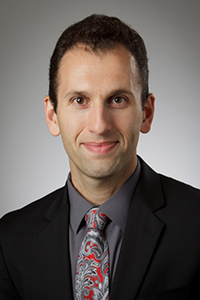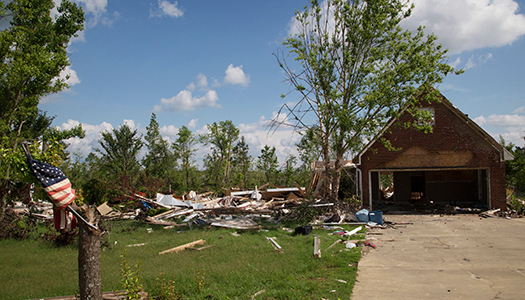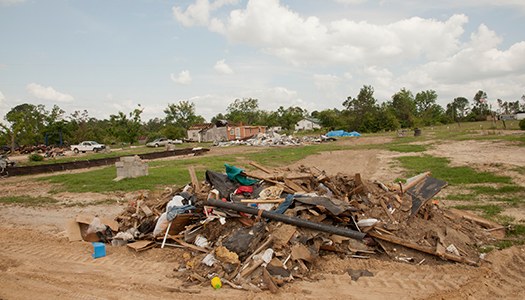Dr. Ali Nejat Awarded $500,000 NSF CAREER Grant to Create RecovUS: An Agent-Based Model of Collective Housing Recovery After Disasters
By Amanda Miller

An anticipated exponential increase in future extreme events coupled with the growing population in disaster-prone regions has created an urgent need for better understanding of the process of disaster recovery and more effective strategies to enhance recovery policies. This improved understanding and action could lead to fewer casualties and save federal resources. Understanding this process entails exploring important factors that influence recovery. For example, housing makes up the majority of building stock in any community and is not only a major sector of the nation's financial infrastructure, but also a key component of its social infrastructure. The reestablishment of housing is known to be a crucial parameter in understanding recovery processes as it has a ripple effect on the overall timing of recovery.
According to existing literature, housing recovery as the center of households' long-term recovery is one of the least studied topics in the field of disaster recovery studies. This is due to two characteristics of this topic. First, housing recovery is complex, driven by a multitude of influencing parameters. Second, housing recovery is collective in nature. Families are shown to have a tendency to return or relocate together. Disasters are perceived as collective stress situations and disaster recovery is shown to be significantly reliant on social networks and psychological well being of the affected households. Because of this, it can be concluded that disaster recovery is not only the act of individuals but also a collective action founded on extensive interactions between the members of households and their social networks.
Literature on modeling disaster recovery covers many topics from loss estimation models to economic impact models and from models studying interventions in infrastructure to models investigating recovery trajectories. Although these studies have covered a variety of aspects of disasters, there is still no research on integrating topology and social interaction among households and spatial effects of households' environment and economy on their housing recovery decisions. Bridging the gap between household interactions and environmental or external factors would allow for a more thorough assessment of the recovery process, and more informed disaster policymaking.

Dr. Ali Nejat, assistant professor of civil, environmental, and construction engineering at Texas Tech, is working to provide greater understanding in this field. Receiving a $500,000 CAREER award from the National Science Foundation (NSF), Nejat plans to create an agent-based modeling system to analyze recovery behavior, specifically of households, following a natural disaster. This model will be comprised of several intelligent decision-making agents, calibrated and validated utilizing existing data collected from previous real-world disasters. The sensitivity of households' recovery decisions to a given recovery policy will also help assess its effectiveness which in turn will lead to an optimized recovery plan for a given community.
See all 2015 NSF CAREER Award winners in the Class of 2015 Early Career Engineers to Watch.
The multi-agent system will be based on a conceptual framework which is founded on empirical research. This framework will encompass a multitude of internal and external parameters. Internal factors will include households' demographics, social networks, experience, socioeconomic, psychosocial factors, and disaster exposure. External factors will incorporate disaster recovery policies from any member of the recovery assistance framework and spatial changes in the proximity of households that might trigger their reconstruction. The multi-agent system will be GIS-enabled to accommodate agents' spatial topology together with their social network topology and the available infrastructure. Households' social networks will be identified and modeled through performing surveys and synthesized using census data and heuristics.
Next, Nejat will assign a decision-making structure to create the agent-based model. For this research, the proposed structure will allow utility-based agents to use a metric to designate their level of satisfaction in their current state. The agents are involved in a game wherein each waits to see what others will do while simultaneously making their own decisions. The game in its simplest form entails making a decision between two basic options: reconstruction or waiting. Each household is assumed to be in a "waiting game" with other neighboring households to start reconstruction. A transformative game-theoretic approach would account for a high level of complexity due to the influence of various internal and external variables. Lastly, Nejat will apply verification and validation to the lifecycle of the model using primary and secondary data encompassing a wide range of phases and tests. Model verification is performed to ensure that the model works as intended while model validation is used to ensure the predictability of the model and its application to real-world problems.
Several distinguished Ph.D. students will work with Nejat in creating the agent-based model. A new course will discuss agent-based modeling and its applications in infrastructure management. Inter and intra-university competitions will challenge students to utilize the model to effectively adopt policies for a hypothetical disaster situation which is among one of Nejat's main outreach plans. This bottom-up micro-scale approach will allow for simulation of interactions among households to mimic real events. These simulations will enable policymakers to assess the efficacy of their recovery policies through the developed model. The behavioral model will be modular, scalable, and can be easily extended to any type of disaster. Therefore, Nejat's model could have potential applications for many different disasters, including natural disasters, man-made disasters, terrorist attacks, or major outbreaks. The multidisciplinary nature of this research and its diversified pedagogy together with its embedded social interaction protocols will allow more effective research and teaching, broader involvement of underrepresented groups as well as multiple stakeholders in related research. Ultimately, this research will enable effective disaster recovery planning for a given community.

Grant Title:
CAREER: RecovUS - An Agent Based Model of Collective Post Disaster Housing Recovery
Edward E. Whitacre Jr. College of Engineering
-
Address
100 Engineering Center Box 43103 Lubbock, Texas 79409-3103 -
Phone
806.742.3451 -
Email
webmaster.coe@ttu.edu
